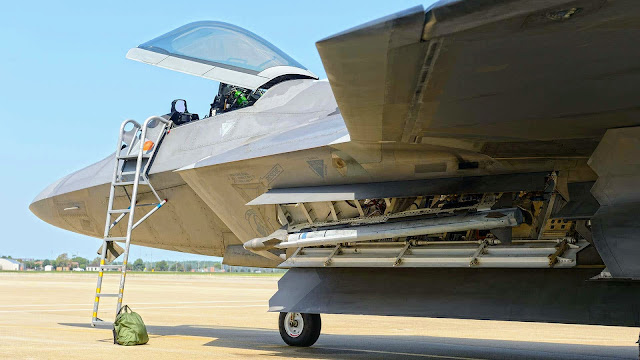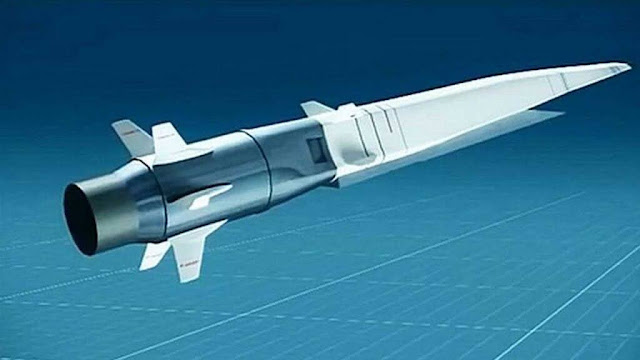
|
| China may target the F-22 Raptor with hypersonic missiles |
- All heat-seeking missiles can easily target an aircraft by pursuing the heat signature.
- The key to the Chinese claim is that a hypersonic weapon would still need to be fired from a "small distance" and when the aircraft is relatively low to the ground.
The F-22 Raptor's unstoppableness. China even tries. China may target the F-22 Raptor with hypersonic missiles. Even though it's fast, the F-22 can't outrun a hypersonic missile, and China is reportedly looking into ways to target the F-22, the best US combat aircraft. China claims to have developed a "short-range" hypersonic weapon. The Chinese media also noted that 90% of aircraft lost in the 1980s were due to heat-seeking missiles, but they didn't address why.
The Lockheed Martin F-22 Raptor is revered not only for its air-to-air maneuverability but also for its ability to engage in dogfights, and this is especially true when compared to any other aircraft that might pose a threat in the future. The Advanced Tactical Fighter (ATF) program, which began twenty years ago, was responsible for the development of the Raptor, which is a fighter jet that is only used by the United States Air Force. The plane was designed to be a fighter capable of achieving air superiority while also being able to attack ground targets, engage in electronic combat, and gather signals intelligence.
It is able to reach speeds of Mach 2, which is equivalent to 1,534 miles per hour or 2,469 kilometers per hour. It is powered by two Pratt & Whitney Turbofan engines. The maximum altitude that the F-22 can reach is 50,000 feet (15 kilometers), and it has a range of 1,841 miles (2,962 kilometers) before it needs to refuel.

|
| what reason the F-22 Raptor is unstoppable |
China is reportedly looking into ways to use hypersonic missiles to target the F-22 Raptor
Even though it's fast, the F-22 can't outrun a hypersonic missile, of course, and there are reports that China is reportedly looking into ways to use such technology to target the F-22, which is the best combat aircraft in the United States' arsenal. In December of this past year, a Chinese scientist even made the audacious (and even questionable) claim that a "ground-to-air hypersonic missile could catch up and destroy an F-22 (Raptor) in seconds if it fired a missile or dropped a bomb from short range." This statement was made in reference to a hypothetical scenario.
These missiles, which are capable of "heat-seeking," have the ability to zero in on "practically any target with remarkable accuracy and speed." According to the researchers' claims, potential targets could include stealth aircraft, ships, and even moving vehicles on the street. While the majority of military ground vehicles travel at speeds of no more than 60 miles per hour, and ships slowly trudge across the open water, there are some exceptions.

|
| Artist Modelling of Heat Seaking Missile |
China claims to have developed a hypersonic weapon that can attack from a "short-range"
The Chinese media also highlighted the fact that data from the United States Air Force showed that heat-seeking missiles were responsible for 90 percent of all aircraft lost in the 1980s, but they failed to address the fact that the United States was responsible for the majority of those kills. Following the aircraft's heat signature makes it simple for all heat-seeking missiles to home in on their target. A passive method of guiding missiles, also known as infrared homing, heat-seeking refers to the process by which the missile locates and focuses its attention on the target by making use of the electromagnetic radiation that the target emits in the infrared region of the electromagnetic spectrum.
The Chinese claim hinges on the fact that a hypersonic weapon would still need to be fired from a "small distance" and when the aircraft is relatively low to the ground in order to be effective. This would imply that a high-flying F-22 at range would still have time to maneuver even if it had to. Both the F-22 Raptor and the more recent Lockheed Martin F-35 Lightning are designed to sneak past an adversary's air defenses and attack their targets from a safe distance. If the enemy doesn't know the aircraft is there, it won't fire a missile at it, regardless of whether or not it is hypersonic.
Last but not least, today's aircraft of the fifth generation, such as the F-22, which was developed specifically as a fighter plane for air superiority, are able to target an adversary from a distance that is significantly further than what is visually possible. There is no question that a hypersonic heat-seeking missile poses a threat, but it is highly unlikely to be anywhere near as significant as the Chinese researchers would like to make it seem.

